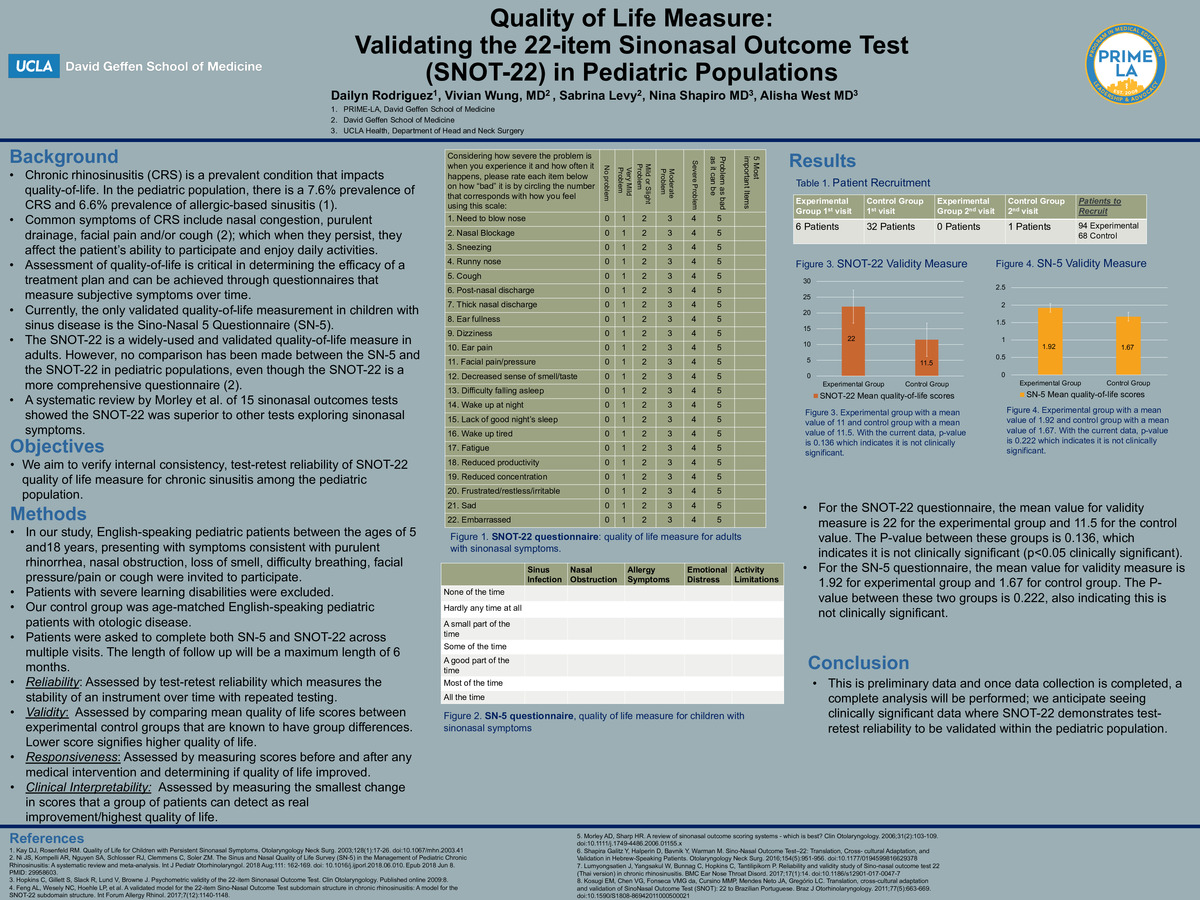-
Author
Dailyn Rodriguez Reyes -
PI
Dr. Alisha West, Dr. Nina Shapiro
-
Co-Author
Dr. Vivian Wung, Sabrina Levy
-
Title
Quality of Life Measure: Validating the 22-item Sinonasal Outcome Test (SNOT-22) in Pediatric Population
-
Program
CTSI TL1 Summer Program
-
Other Program (if not listed above)
-
Abstract
Abstract
Background
- Chronic rhinosinusitis (CRS) is a prevalent condition that impacts quality-of-life. In the pediatric population, there is a 7.6% prevalence of CRS and a 6.6% prevalence of allergic-based sinusitis (1).
- Common symptoms of CRS include nasal congestion, purulent drainage, facial pain and/or cough (2); which when they persist, they affect the patient’s ability to participate and enjoy daily activities.
- Quality-of-life is critical in determining the efficacy of a treatment plan and can be achieved through questionnaires that measure subjective symptoms over time.
- Currently, the only validated quality-of-life measurement in children with sinus disease is the Sino-Nasal 5 Questionnaire (SN-5).
- The SNOT-22 is a widely-used and a validated quality-of-life measure in adults. However, no comparison has been made between the SN-5 and the SNOT-22 in pediatric populations, even though the SNOT-22 is a more comprehensive questionnaire (3).
- A systematic review by Morley et al. of 15 sinonasal outcomes tests showed the SNOT-22 was superior to other tests exploring sinonasal symptoms.
Objectives
We aim to verify internal consistency, test-retest reliability, of SNOT-22 quality of life measure for chronic sinusitis among the pediatric population
Methods
- In our study, English-speaking pediatric patients between the ages of 5 and18 years, presenting with symptoms consistent with purulent rhinorrhea, nasal obstruction, loss of smell, difficulty breathing, facial pressure/pain and/or cough are included.
- Patients with severe learning disabilities were excluded.
- Our control group was age-matched English-speaking pediatric patients with otologic disease.
- Patients were asked to complete both the SN-5 and SNOT-22 across multiple visits. The length of follow up will be a maximum length of 6 months.
- Reliability: Assessed by test-retest reliability which measures the stability of an instrument over time with repeated testing.
- Validity: Assessed by comparing mean quality of life scores between the experimental and the control groups that are known to have group differences. Lower score signifies higher quality of life.
- Responsiveness: Assessed by measuring scores before and after any medical intervention and determining if quality of life improved.
- Clinical Interpretability: Assessed by measuring the smallest change in scores that a group of patients can detect as real improvement/highest quality of life.
Results:
- For the SNOT-22 questionnaire, the mean value for the validity measure is 22 for the experimental group and 11.5 for the control value. The P-value between these groups is 0.136, which indicates it is not clinically significant (p<0.05 clinically significant).
- For the SN-5 questionnaire, the mean value for the validity measure is 1.92 for experimental group and 1.67 for control group. The P-value between these two groups is 0.222, also indicating this is not clinically significant.
Conclusion
- This is preliminary data and once data collection is completed, a complete analysis will be performed; we anticipate seeing clinically significant data where SNOT-22 demonstrates test-retest reliability to be validated within the pediatric population.
References
- Kay DJ, Rosenfeld RM. Quality of Life for Children with Persistent Sinonasal Symptoms. Otolaryngology Neck Surg. 2003;128(1):17-26. doi:10.1067/mhn.2003.41
- Ni JS, Kompelli AR, Nguyen SA, Schlosser RJ, Clemmens C, Soler ZM. The Sinus and Nasal Quality of Life Survey (SN-5) in the Management of Pediatric Chronic Rhinosinusitis: A systematic review and meta-analysis. Int J Pediatr Otorhinolaryngol. 2018 Aug;111: 162-169. doi: 10.1016/j.ijporl.2018.06.010. Epub 2018 Jun 8. PMID: 29958603.
- . Hopkins C, Gillett S, Slack R, Lund V, Browne J. Psychometric validity of the 22‐item Sinonasal Outcome Test. Clin Otolaryngology. Published online 2009:8.
- Feng AL, Wesely NC, Hoehle LP, et al. A validated model for the 22-item Sino-Nasal Outcome Test subdomain structure in chronic rhinosinusitis: A model for the SNOT-22 subdomain structure. Int Forum Allergy Rhinol. 2017;7(12):1140-1148. doi:10.1002/alr.2202
- Morley AD, Sharp HR. A review of sinonasal outcome scoring systems - which is best? Clin Otolaryngology. 2006;31(2):103-109. doi:10.1111/j.1749-4486.2006.01155.x
- Shapira Galitz Y, Halperin D, Bavnik Y, Warman M. Sino-Nasal Outcome Test–22: Translation, Cross- cultural Adaptation, and Validation in Hebrew-Speaking Patients. Otolaryngology Neck Surg. 2016;154(5):951-956. doi:10.1177/0194599816629378
- Lumyongsatien J, Yangsakul W, Bunnag C, Hopkins C, Tantilipikorn P. Reliability and validity study of Sino-nasal outcome test 22 (Thai version) in chronic rhinosinusitis. BMC Ear Nose Throat Disord. 2017;17(1):14. doi:10.1186/s12901-017-0047-7
- Kosugi EM, Chen VG, Fonseca VMG da, Cursino MMP, Mendes Neto JA, Gregório LC. Translation, cross-cultural adaptation and validation of SinoNasal Outcome Test (SNOT): 22 to Brazilian Portuguese. Braz J Otorhinolaryngology. 2011;77(5):663-669. doi:10.1590/S1808-86942011000500021
- Vaitkus S, Padervinskis E, Balsevicius T, et al. Translation, cross-cultural adaptation, and validation of the sino-nasal outcome test (SNOT)-22 for Lithuanian patients. Eur Arch Otorhinolaryngology. 2013;270(6):1843-1848. doi:10.1007/s00405-012-2282-2
- de los Santos G, Reyes P, del Castillo R, Fragola C, Royuela A. Cross-cultural adaptation and validation of the sino-nasal outcome test (SNOT-22) for Spanish-speaking patients. Eur Arch Otorhinolaryngology. 2015;272(11):3335-3340. doi:10.1007/s00405-014-34370
- Lange B, Thilsing T, Al-kalemji A. The Sino-Nasal Outcome Test 22 validated for Danish patients. Dan Med Bull.:6.
- Schalek P, Otruba L, Hahn A. Quality of life in patients with chronic rhinosinusitis: a validation of the Czech version of SNOT-22 questionnaire. Eur Arch Otorhinolaryngology. 2010;267(3):473-475. doi:10.1007/s00405-009-1180-8
-
PDF
-
Zoom

